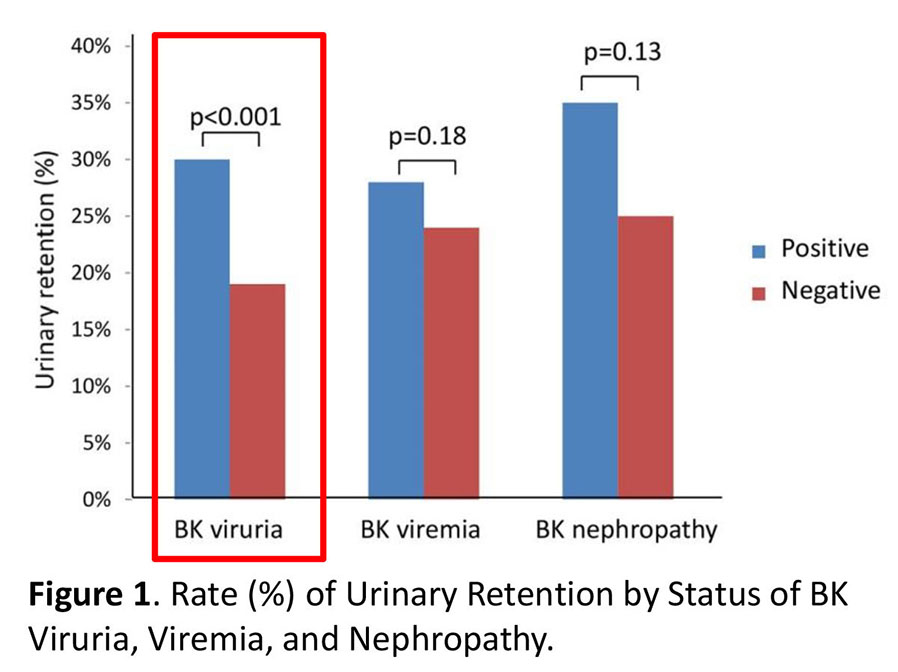Urinary Retention Associated with Polyomavirus (BK) Viruria and Higher Peak Blood BK Following Kidney Transplant (KTx).
1Nephrology and Hypertension, Mayo Clinic, Rochester, MN
2The William J von Liebig Center for Transplantation and Clinical Regeneration, Mayo Clinic, Rochester, MN
Meeting: 2017 American Transplant Congress
Abstract number: 239
Keywords: Kidney, Kidney transplantation, Polyma virus, Risk factors
Session Information
Session Name: Concurrent Session: Kidney BK Virus
Session Type: Concurrent Session
Date: Monday, May 1, 2017
Session Time: 2:30pm-4:00pm
 Presentation Time: 3:42pm-3:54pm
Presentation Time: 3:42pm-3:54pm
Location: E451a
BACKGROUND: BK nephropathy is a major risk factor for allograft dysfunction and loss. BK viruria and viremia are early markers of BK nephropathy in KTx recipients. The aim of this study was to investigate the association between urinary retention and BK viruria, viremia, and nephropathy.
METHODS: We performed a retrospective cohort study of solitary KTx recipients from 10/2007 – 5/2014 to examine the relationship between urinary retention (post-void residuals >200cc) and BK viruria, viremia, and nephropathy. All KTx patients at our center had post-void residuals tested by ultrasound or urinary catheter when they had iothalamate renal clearance testing (at 1, 4, and 12 months post-transplant, and annually).
RESULTS: Of 962 KTx recipients, 49.7% had BK viruria, 29.5% had BK viremia, 4.5% had BK nephropathy and 24.9% had urinary retention during mean follow-up of 4.1+/-1.9 years post-transplant. BK viruria was associated with urinary retention (30.5% in patients with BK viruria vs 19.4% in those without BK viruria, p<0.001). We also found that acute cellular rejection was associated with BK viruria (9% in patients with BK viruria vs 5% in those without BK viruria, p=0.04). After adjusting for acute cellular rejection, the association between urinary retention and BK viruria remained [OR 1.8 (95% CI 1.3–2.4)]. Peak blood BK PCR was also significantly higher in those with urinary retention [mean+/-SD of 113,955+/-317,511 vs 37,746+/-105,661 copies, p=0.04]. Patients with BK viremia and BK nephropathy also had numerically higher rates of urinary retention, but this did not reach statistical significance.  CONCLUSION: KTx recipients with urinary retention are more likely to develop BK viruria and a higher degree of BK viremia than those without urinary retention. Therefore, urinary retention may be a potentially modifiable risk factor for BK nephropathy and potential allograft loss.
CONCLUSION: KTx recipients with urinary retention are more likely to develop BK viruria and a higher degree of BK viremia than those without urinary retention. Therefore, urinary retention may be a potentially modifiable risk factor for BK nephropathy and potential allograft loss.
CITATION INFORMATION: Cheungpasitporn W, Amer H, Cosio F, Schinstock C. Urinary Retention Associated with Polyomavirus (BK) Viruria and Higher Peak Blood BK Following Kidney Transplant (KTx). Am J Transplant. 2017;17 (suppl 3).
To cite this abstract in AMA style:
Cheungpasitporn W, Amer H, Cosio F, Schinstock C. Urinary Retention Associated with Polyomavirus (BK) Viruria and Higher Peak Blood BK Following Kidney Transplant (KTx). [abstract]. Am J Transplant. 2017; 17 (suppl 3). https://atcmeetingabstracts.com/abstract/urinary-retention-associated-with-polyomavirus-bk-viruria-and-higher-peak-blood-bk-following-kidney-transplant-ktx/. Accessed December 21, 2025.« Back to 2017 American Transplant Congress
